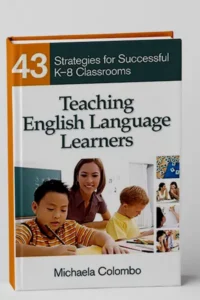Teaching English Language Learners: 43 Strategies for Successful K–8 Classrooms provides teachers of all content areas with a broad, practical approach to teaching English language learners in the regular classroom setting.
Teaching English Language Learners: 43 Strategies for Successful
Ideal as a supplementary text for a variety of courses and as a guide for in-service teachers and for professional development settings. This strategy book addresses the needs of the regular classroom teacher who is teaching one or more ELLs along with fully English proficient (FEP) learners.
It will provide you with strategies that are grounded in research and theory to enable you to provide appropriate instruction to this growing population of students. While it is not possible in a book of this nature to provide a comprehensive discussion of theories and research, the Resource section at the end of each unit provides additional readings.
Book Features
Ten key features make this book accessible to readers who are using this book as part of coursework assignments, as professional development, or as an independent guide.
- Each unit is aligned with the TESOL teacher and student standards. In addition, student performance indicators are provided for Units III through VIII.
- Each unit includes a listing of what readers will know, understand, or be able to do as a result of that unit.
- The Introduction provides a brief history of educating English language learners in the United States, an overview of current programs, and student demographics. An overview of theories is presented in an easy-to-read table format.
- The strategies included are doable within the context of the regular classroom and are accompanied by underlying theories and research, which allows teachers to understand why the strategies are likely to be effective with English language learners in the regular classroom and encourages the extension of strategies.
- The implementation for each strategy is presented in an easy to follow, step-bystep format.
- Each strategy is followed by a Strategy in Action section, which illustrates the strategy in a variety of regular classroom situations.
- A Reflections section after the Strategy in Action section provides questions that can be used by a course instructor or independently by the reader.
- A Strategy Resources section is included at the end of each unit opener and, when relevant, at the end of each strategy. The resources include further research that underlies the strategies, additional examples of strategies in use or ways to extend strategies, and videos that illustrate strategies in action. The Resources section provides the course instructor with additional reading and assignments for participants and provides the individual reader with materials for self-study.
- New terms are glossed over within the text.
- Charts and rubrics are included to help readers plan instruction and to measure the progress of the English language learners in their classrooms.
How Best to Use this Book
This book is divided into nine units: the introduction, which you are now reading, and eight additional units. Each unit focuses on strategies in one area: managing the learning environment, working with other school professionals, assessment, comprehensibility, vocabulary, oral language development, reading and writing, and building home-schoolAfter reading the Introduction, you may skip from unit to unit. Each unit begins with an overview of the broad underlying research and the TESOL student performance indicators for the strategies presented. The overview is useful for understanding the strategies presented within the unit. I encourage you to read this overview prior to connections.
This Introduction provides an overview of the needs of regular classroom teachers, a brief history of the education of ELLs in U.S. schools, an explanation of the types of programs that currently exist for ELLs, and a brief description of several accepted theories for teaching ELLs. The Resource section at the end of this unit provides suggestions for further reading as well as links to videos that illustrate the theories and strategies.
After reading the Introduction, you may skip from unit to unit. Each unit begins with an overview of the broad underlying research and the TESOL student performance indicators for the strategies presented. The overview is useful for understanding the strategies presented within the unit. I encourage you to read this overview prior to reading the strategies and then to revisit it as you plan to implement the strategies with your students.


